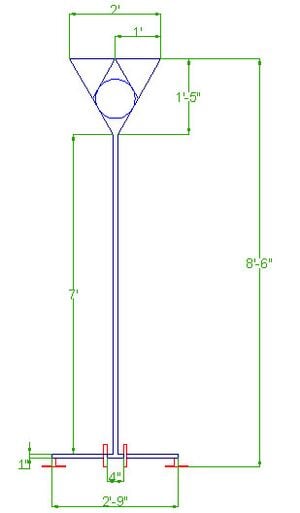
This page is about the Hyper Visible Power Meter. It was constructed for the Flock House Project in New York City by Team Stark Industries during the Fall 2011 Engineering 215 - Introduction to Design class at Cal Poly Humboldt. We were tasked with the creation of a meter to provide information about the energy storage system of the Flock House. This meter will be utilized daily by the Flock House for the duration of its travels around New York City. The meter serves as both an educational tool for the public as well as a tool for the artists living aboard by presenting an alert when power levels are too low.
-
CAD Drawing of the Power Meter
-
Electrical work
-
LEDs' testing with Arduino
-
Testing computer fan attached to Arduino
-
Base of Power Meter
Background[edit | edit source]
The Flock House Project[edit | edit source]
The Flock House is a self sustaining pod that will travel around the neighborhoods of New York City to teach the public about sustainability during Summer 2012. It will serve as a home for two artists who will live in the pod as it travels through the city.
Team Stark Industries[edit | edit source]
Team Stark Industries is a team of four students enrolled in Fall 2011 Engineering 215 Intro to Design at Cal Poly Humboldt.
Problem Statement and Criteria[edit | edit source]
The objective is to design a power meter which displays two types of data: the status of the battery and the power generated by volunteers for the Flock House. The display must be clearly visible from at least 20 feet and be visually appealing to the public.
Criteria[edit | edit source]
| Criteria | Weight(1-10) | Description |
|---|---|---|
| Visibility | 10 | Display data clearly and simply up to 20 ft. |
| Power Draw | 9 | Lowest energy use with highest visibility |
| Durability | 9 | Resist elements, protect electronics, deter vandalism |
| Portability | 7 | Easy to set up, adaptable location |
| Reproducibility | 6 | Detailed step by step instructions |
| Cost | 4 | Budget of $375 |
Final Solution[edit | edit source]
-
Final Design
The final solution consists of a diamond shape roof to contain a calibrated infinite illusion mirror to demonstrate the power of the Flock House. Inside the infinite illusion mirror, a ring of LEDs in between two reflective lenses create an infinite illusion effect. The circuit board that was soldered together by the Stark Industries Team is housed inside the metal diamond shaped roof and measures voltages of the battery. The Arduino lily pad is also used in this project. It is used for calibrating the blink and flash of LED lights to display power being generated by bike generating volunteers.
Costs[edit | edit source]
Implementation Costs[edit | edit source]
| Materials | Use | Quantity | Estimated Total Price | Actual Price |
|---|---|---|---|---|
| Aluminum plates | Frame to support meter | 15 | $150.00 | $0.00 |
| Arduino Lily pad micro-controller | Electronics to measure power | 3 | $39.99 | $39.99 |
| Wheels | Transportability | 4 | $25.00 | $0.00 |
| Aluminum tubing | Supports meter | 4 | $20.00 | $0.00 |
| LED lights | Visibility | 100 | $6.99 | $6.99 |
| Circuit board | Electronics to measure battery | 1 | $42.00 | $42.00 |
| Electronic wires | Electronics | 5 | $1.00 | $0.00 |
| Electrical conduit | Protects wires | 1 | $24.00 | $24.00 |
| Silicon caulking | Seal housing against elements | 1 | $6.00 | $6.00 |
| Total Cost | $314.98 | $118.98 | ||
Maintenance Costs[edit | edit source]
| Item | Estimated Annual Cost |
|---|---|
| Aluminum Materials | $3.50 |
| LEDS | $1.00 |
| Electronics | $3.50 |
| Wheels | $1.00 |
Testing Results[edit | edit source]
-
Testing LED lights on Breadboard
-
Testing on Car Battery
-
Testing the inner ring LEDs with Arduino
-
Testing soldering connections on inner ring
-
Testing the infinity effect
-
Testing interior connections
Step by step instructions[edit | edit source]
For instructions: hyper visible power meter instructions
Discussion[edit | edit source]
The final product of hyper visible power meter met the criteria of high visibility, low power draw, high durability, excellent portability, easy reproducibility, and low cost.
References[edit | edit source]










